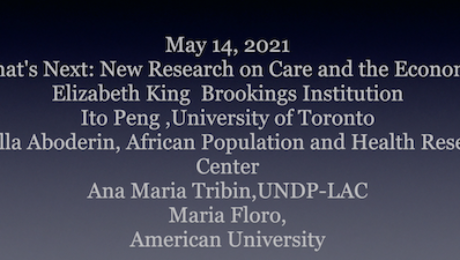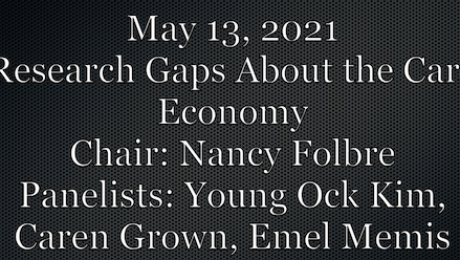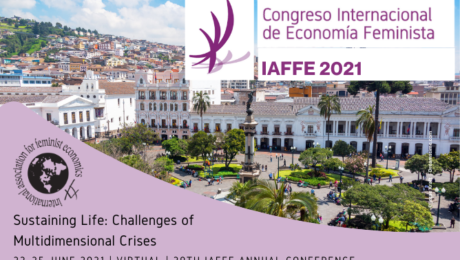The Next Steps for Research on Care and the Economy
The third day of the Concluding Annual Meeting was marked by reflection of the project and sharing research plans for the future. Dr. Ito Peng (University of Toronto) introduced the next step of research that is taking a wider, global lens and then Dr. Isabella Aboderin (Perivoli Africa Research Centre) and Dr. Ana Maria Tribin (Central Bank of Colombia) gave details about the context and goals for the region they are concentrating on for the project.
The next leg of the project will be based at the University of Toronto, and it will scale up the research to a global and comparative level. It will aim to adapt methods used for South Korea and innovate new methods in order to study eight countries from four separate regions around the world. For each country/region, they plan to conduct two large surveys, a time use and an interview survey about care giving and receiving. This multi-country approach will enable the researchers to produce detailed and nuanced data and insights and be able to see the interaction of the care economy with different cultures and policies.
The data collection and research will be spearheaded by grassroots organizations and native researchers. Dr. Aboderin emphasized the goal of the African branch of the project is to generate Africa-centered knowledge about the importance of early childhood and long-term care. As for the Latin America portion of the project, specifically Colombia, Dr. Tribin spoke about the need to provide the public and policy makers with qualitative and quantitative tools and data to understand the large gender gaps in the labor market in the region.
To hear the full discussion and learn more details about the next steps of the project, see below.
Written by Catherine Falvey, Research Assistant for the Care Work and the Economy project and PhD student in Economics at American University
- Published in Conferences, Expert Dialogues & Forums, Maria Floro, Policy, Research
Research Gaps about the Care Economy
To wrap up the second day of the Concluding Annual Meeting, Dr. Nancy Flobre (University of Massachusetts Amherst) chaired a discussion on future avenues for research in the field of care economy. Young Ock Kim (Korean Women’s Development Institute) suggested modifying existing macroeconomic models and going beyond the models being used currently. Kim pointed out that research could also focus on the recovery from the COVID-19 pandemic and that some surveys might need to adjust their timelines to make sure that the effects of the pandemic are captured. Finally, it is vital to encourage young researchers to engage in care economy research, and a research fund could achieve this objective.
Dr. Emel Memiş (Levy Institute) emphasized the importance of gathering quality information for future research. Memiş’highlighted current data challenges such as the lack of complete information on income and consumption patterns of the households, the need for more classifications for time use data and detailed information on paid work time use and paid work activities, the lack of data on the intersection of inequalities such as regional inequalities, and ethnic-based inequalities. In conclusion, high-quality data is necessary for research that encapsulates all aspects of wellbeing, economic and non-economic life activities.
The need for strategies to incorporate new technology to collect data and disseminate research findings was Dr. Caren Grown’s (World Bank) main message. Furthermore, research needs to focus on low-income, low resource, transitioning, and emerging economies so that models could be developed to include the idiosyncrasies of these types of economies. When conducting research, it is also important to distinguish between different risk profiles and the different types of care populations. Grown encouraged the research community to be innovative in disseminating research findings to reach a wider audience.
To watch the full presentation, see below.
Written by Praveena Bandara, Research Assistant for the Care Economy Project and PhD student in Economics at American University.
- Published in Conferences, Expert Dialogues & Forums, Policy, Research
CWE-GAM Scholars Leading Two Panels During 2021 IAFFE Annual Conference
This week, the International Association for Feminist Economics (IAFFE) will hold its Annual Conference: “Sustaining Life: Challenges of Multidimensional Crises” starting on Tuesday, June 22nd, and concluding Friday, June 25th. This conference will provide a forum for scholars to discuss feminist approaches to constructing “inclusive and resilient economic and political systems and [sustainting] our environment” in the context and aftermath of the COVID-19 pandemic.
The Care Work and the Economy Project will be leading two panel discussions on Wednesday, June 23rd and Thursday, June 24th: “Those Who Care: Improving the Lives of Caregivers and Workers” chaired by Elizabeth King and Ito Peng, and “Seeking Gender Aware Applied modelings: Case of South Korea” chaired by Young Ock Kim. In the discussions, CWE-GAM researchers will present gender-aware macroeconomic models, data collected from unique surveys of care providers and families, and microeconomic simulations used to better understand care work and the economy.
“Those Who Care: Improving the Lives of Caregivers and Workers” is scheduled for Wednesday, June 23rd from 3:30 to 5:00 pm (EDT time) and will contribute to ongoing efforts to “illustrate the intersectionality of care provisioning, economic growth, and distribution.” With an increasing need for care due to the rapid decline in fertility rates and aging population, South Korea offers a unique context to introduce models and analyze surveys given to households, child and eldercare workers.
There will be four papers presented in this panel:
“The Effects of Public Social Infrastructure and Gender Equality on Output and Employment: The Case of South Korea” by Cem Oyvat and Ozlem Onaran “introduces a post-Kaleckian feminist model to analyze the effects of public social expenditure and gender gaps on output and employment building on Onaran, Oyvat, and Fotopoulou (2019), and extending it with an endogenous labor supply and wage bargaining model.”
“The Quality of Life of Family Caregivers: Psychic, Physical, and Economic Costs of Eldercare in South Korea” by Jiweon Jun, Elizabeth King, and Catherine Hensly “examines the psychic, physical, and opportunity costs of caregiving within the family using data from a special-purpose national survey of 501 households conducted in Seoul in 2018.”
“Quality of Care, Commitment Level, and Working Conditions: Understanding the Care Workers’ Perspective” by Shirin Arslan, Maria Floro, Arnob Alam, Eunhye Kang, and Seung-Eun Cha uses “the 2018 Care Work Economy (CWE-GAM) survey data collected from 600 child and eldercare workers in South Korea [to] analyze patterns of commitment levels among [paid carers] in various settings such as private and public institutions as well as in homes of recipients by conducting tobit regressions and entropy econometrics for robustness checks.”
“Impacts of COVID-19 on Work-Family Balance in South Korea: Empirical Findings and Policy Implications” by Ito Peng and Jiweon Jun examines COVID-19’s unequal impact between men and women in South Korea using data from a survey distributed to “1,252 households with at least one child aged between 0 and 12 in June 2020 to find out how the first 2-month social distancing measure had affected their work, childcare arrangements, and their wellbeing.”
“Seeking Gender Aware Applied modelings: Case of South Korea” is scheduled for Thursday, June 24th from 3:30 to 5:00 pm (EDT time), which will share the results of gender-aware applied modelings and micro simulations for South Korea. The panel will discuss which fiscal policies are likely to be the most effective at reducing gender gaps in paid employment and which forms of public investment best contribute to reducing and redistributing unpaid work between genders and socio-economic groups.
There will be three papers presented in this panel:
“Child and Elderly Care in South Korea: Policy Analysis with a Gendered, Care-Focused Computable General Equilibrium Model” by Martin Cicowiez and Hans Lofgren presents the first care-focused and gendered model in the computable general equilibrium literature for Korea that “is built around a social accounting matrix (SAM) that covers non-GDP household services, singles out sectors for child and elderly care, and disaggregates households on the basis on care needs.”
“Care Support Ratios in Korea and the US” by Gretchen S. Donehower and Bongoh Kye takes a holistic view of care by including both paid and unpaid care for all age ranges and “create[s] [care support ratios] to understand the current care market and whether it is sustainable in the future…in two aging populations- Korea and the United States.”
“Towards a Caring and Gender-Equal Economy in South Korea: How much does the regulation of labor market working hours matter?” by Ipek Ilkkaracan and Emel Memis “use[s] a unique time-use survey on care arrangements by couples with small children in order to explore the potential of [the] reduction of full-time market work hours towards [the] narrowing of the gender gaps in paid and unpaid work.”
To learn more about the panels presented by CWE-GAM researchers and the IAFFE conference, please visit the IAFFE 2021 Annual Conference homepage and program.
This blog was contributed by Lucie Prewitt, a research assistant for the CWE-GAM project.
Microfinance and the Care Economy
Financial inclusion has been adopted as a developmental strategy with the roll-back of the developmental state under the neoliberal policy regime. As a result, mainstream private finance has utilized microcredit schemes with increasing frequency, even though such schemes initially were touted almost exclusively as tools for gender-empowerment and poverty alleviation. The relatively low rates of default in this sector have attracted an influx of funds from profit-oriented financial institutions, shifting focus from the sustainability of income generation for borrowers to that of the profitability of the lending institution. Given the higher transaction costs associated with small loans and extending outreach to marginal low-income households, this change has undermined the social mission of microfinance to reach the poorest and most neglected households. It appears social priorities are being subordinated to commercial considerations.
The impact of microcredit on both poverty and gender relations has been studied extensively. Yet the implications of microcredit growth for the care-economy, and their repercussions in the wider macro-economy, have received much less analytical attention. This neglect of care-labor provision in particular is surprising given that microfinance originally targeted female workers in rural areas in developing countries with less access to earning opportunities and disproportionate responsibility for care work. The increase in market labor implies a claim on the time of working women. In the absence of social provisioning of care, this claim on the labor time of women likely could lead to a squeeze on the time of rural working women.
We propose a simple two sector post-Keynesian model to integrate the role of demand and care work into the analysis of microfinance. This investigation demonstrates how micro-financed enterprises face a structural constraint on the demand-side from overall macroeconomic conditions. They likewise face a constraint on the supply side from the responsibility for unpaid care work borne by the female beneficiary of microfinance. Paradoxically, microfinance has been espoused as a developmental strategy in precisely the period when the role of the developmental state has been eclipsed and cutbacks in public spending on care provisioning have been prescribed.
Meanwhile, slowdowns in the wider economy lower the demand for the output of the microfinance sector, undermining the viability of these enterprises. The capacity of the microfinance sector to provide the impetus to broader demand growth in the economy therefore is likely to be more limited in the absence of public policies to stimulate demand and investment. The capacity of microfinance to alleviate poverty and lift incomes is thus dependent on conditions in, and linkages with, the wider macroeconomy. A vibrant and stable macroeconomy is the only sustainable basis for a stable microfinance sector.
We also draw attention to some of the complexities of the impact of microfinance for the provision of care. The home-based nature of microenterprise perpetuates the gendered asymmetries of care responsibility within the household. While higher female earnings can alleviate the burden of care by making care work more effective and by enabling the market to substitute for unpaid care, the gendered responsibility for care remains a critical constraint for the female beneficiary of microfinance at the lower income levels and in the context of inadequate social provision of care.
Some clear policy prescriptions emerge from this investigation. Donors and development agencies have been encouraging raising interest rates in order to ensure the viability and profitability of microfinance lenders. However, our model suggests that high interest rates will undermine the scope of microfinance as a path to better and sustainable livelihoods for poor households in rural areas. Higher interest rates in this sector impose a higher burden on the labor-time of the female worker with a consequent squeeze of care-labor or own-labor time.
More significantly, the analysis suggests that microfinance cannot be an effective path to poverty alleviation or gender empowerment, unless it is backed by investment in the social provisioning of care. The success of microfinance as a developmental strategy depends on wider policies that support demand and the social provision of care. Ultimately, there is no substitute for a developmental strategy based on public investment in support of both job creation and social provision of care.
- Published in Research, Rethinking Macroeconomics
(More) Economic Lessons from the Great Recession of 2008
The global financial crisis that began in 2008 resulted in the widespread destruction of jobs. Effects were felt disproportionately among subordinate racial groups and women. While mainstream analyses emphasize regulatory lapses in the financial sector as the principal factor triggering the crisis, the root causes run much deeper. Feminist and stratification economists have enlarged the lens of economists to explore the role that growing inequality played leading up to the crisis. Furthermore, they have made important contributions to the analysis of the macro-level impact of crisis and, with this, to macroeconomic theory and policy (for a detailed discussion, see Seguino 2019).
- Cuts to social spending and economic instability have long-term negative effects on human development and productivity, in part through the gender effects of crisis and austerity.
Women tend to bear greater responsibility than men when it comes to ensuring children receive proper care. They are also among the hardest hit by crises and austerity because they control fewer resources and are more concentrated in low-wage jobs that are insecure and lack benefits (Karamessini & Rubery 2013). Because of women’s predominant responsibility for social reproduction, these effects subsequently are transmitted to children—and the impact can be long-lasting. Neuroscience research over the last 20 years details the mechanisms by which this occurs, but economists have yet to recognize its lessons and significance (Katsnelson 2015; Hair et. al., 2016). Children’s brains are especially susceptible to neurobiological changes, and the effects are harsher on poorer than on wealthier families. A recent study shows, for example, that the brains of children and adolescents with higher family income and more parental education have larger surface areas than their poorer, less-educated peers (Noble et. al., 2015). The regions of the brain most affected are those associated with language, executive functioning, motional control, and memory, negatively impacting the development of children’s cognitive skills. These effects last well into adult life.
This research suggests that economists must redefine their conception and scope of hysteresis, or path dependence. Until now, hysteresis only has been applied to the current labor force, but neuroscience research demonstrates the long-term effects of deprivation on the human brain, especially in children. The economic vulnerability of women and people of color affects children and thus long-run productivity growth. Many macroeconomists have not yet integrated this channel of productivity growth into macro models. Were they to do this, the problem of gender and racial inequality and the shredding of the social safety net would receive the attention they deserve as determinants of long-run growth.
- Targeted public investment can reduce intergroup inequalities and stimulate growth.
Time-use research finds that women are responsible—through gender norms and stereotypes—for a disproportionate share of unpaid work, comprised of care of self and others, and maintenance of the household. Women’s unpaid care burden, crucial for supporting and expanding human capacities of the current and future labor force, inhibits their participation in paid work. Women’s limited access to income, as a result, redounds negatively on children, given evidence of their greater (than male) responsibility for children’s well-being (Doss 2013). This points to the centrality of public investment to reduce women’s care burden.
A number of scholars have explored the gender effects of physical infrastructure investment (in, for example, sanitation, roads, and electricity) [Agénor et. al., 2010]. They find that such investments reduce women’s care burden, particularly in low-income countries where women spend a significant amount of time on unpaid work such as fetching water and firewood. Because these investments help to reduce time poverty (due to time spent on unpaid work), they expand women’s ability to take on paid work, which in turn increases their bargaining power in the household to direct resources to children, promoting long-run productivity growth as a result.
Similarly, physical infrastructure investments can be used to address racial inequalities. In developed countries, for example, residential segregation combines with infrastructure inequality, as the recent case of contaminated water in Flint, Michigan has shown. In addition, lead, asbestos, and chemical toxins worsen the health of children in those communities with life-long effects on their cognitive development and thus productivity. These conditions represent a key aspect of intergroup inequality. But they also have macroeconomic implications as a result of the effect on labor productivity and thus growth.
- Social infrastructure spending promotes gender equality, productivity growth, and creates fiscal space.
Keynesian economists emphasize the effect of government spending on aggregate demand and growth. Feminist heterodox economists take this further, underscoring the importance of strategically targeting government spending to achieve a broader set of goals, including gender and racial equality, and productivity growth. They thus contribute to an understanding of both the demand- and supply-side effects of government spending.
Targeting government spending to social infrastructure (which includes such sectors as childcare, education, and health) expands human capacities. Qualities that make human beings economically effective, such as emotional maturity, patience, self-confidence, and the ability to work in teams have a public goods quality with positive spillover effects on economy-wide productivity (Braunstein, et. al. 2011). Because care work (both paid and unpaid) is a highly gendered activity, with women providing the bulk of the labor, social infrastructure investment can improve women’s access to paid work.
In a recent study, Dehenau & Himmelweit (2016) assess the impact of a public investment of 2% of GDP to either the care or construction sector. They find that in the short-term, government spending targeted to the care sector reduces women’s unpaid work and creates more paid jobs than spending in the construction sector. In the medium term, wages in care sector rise. Given that this sector is one that is female-dominated in employment, the gender wage gap narrows. In the long term, productivity rises due to improvements in human capacities. Antonopoulos et. al. (2011) obtain similar results, with the added outcome that in the US, social service jobs have stronger positive effects on disadvantaged and poor workers (that is, women and people of color).
This spending also has the salutary effect of creating fiscal space over the medium run. As a result, feminist research highlights that it is useful substitute the term social spending with social infrastructure spending, because targeted spending on social infrastructure produces a stream of financial returns into the future due to impact on productivity and incomes. As such, using fiscal policy to promote gender and racial equality creates fiscal space. It is time for economists to begin thinking of such spending as an investment rather than merely as a form of discretionary spending, or a target for cuts during hard economic times.
Macroeconomists, and for that matter economists and policymakers more generally, can benefit from a greater focus on intergroup inequalities by race and gender. This is because macro policy has differential race, gender and class effects. Policies (and models) that fail to incorporate the dynamic effects of intergroup inequality can lead to unintended and harmful outcomes. And intergroup inequality in turn affects important macroeconomic outcomes, including employment and productivity growth.
On the policy side, while explicitly targeted gender and race policies may be helpful, it should be noted that policies that may appear to be gender and race neutral can nevertheless close gaps. For example, sector-specific fiscal spending, full-employment policies, capital controls that reduce volatility, and labor market regulations to address insecure work may benefit all workers but be particularly effective in improving the lives of people of color and women, all with simultaneous economy wide-benefits on productivity growth.
The bottom line:
For some macroeconomists, gender and racial inequality and the impact of macro policies on children may appear to be outside their realm of focus. They are encouraged to resist the temptation to focus their sights too narrowly. Just as class dynamics have macroeconomic implications as demonstrated by Kaleckian economists, so too do gender and race. The effects are not only on the demand side, but also on the supply side of the economy with important implications for fiscal policies that that ensure a path to equity-led growth.
This blog was authored by Stephanie Seguino.
REFERENCES
Agénor, P.-R, Canuto, O., & da Silva, L. P. (2010). On Gender and Growth: The Role of Intergenerational Health Externalities and Women’s Occupational Constraints. World Bank Policy Research Working Paper No. 5492.
Antonopoulos, R., Masterson, T., & Zacharias, A. (2011). Investing in Care: A Strategy for Effective and Equitable Job Creation. In Antonopoulos, A. (ed), Gender Perspectives and Gender Impacts of the Global Economic Crisis, London: Routledge, pp. 47-72.
Braunstein, E., van Staveren, I., & Tavani, D. (2011). Embedding Care and Unpaid Work in Macroeconomic Modeling: A Structuralist Approach. Feminist Economics 17(4), 5-31.
De Henau, J. & Himmelweit, S. (2016). Developing a Macro-Micro Model for Analysis of Gender Impacts of Public Policy. Paper presented at Gender and Macroeconomics: Current State of Research and Future Directions, Levy Economics Institute, Bard College, New York City, March 9, 2016.
Doss, C. (2013): Bargaining and Resource Allocation in Developing Countries. World Bank Research Observer 28(1): 52–78.
Hair, N., J. Hanson, B. Wolfe, and S. Pollak. (2105). “Association of Child Poverty, Brain Development, and Academic Achievement. JAMA Pediatrics 169(9), 822-829.
Karamessini, M. & Rubery, J. (2013). Women and Austerity: The Economic Crisis and the Future for Gender Equality, Routledge IAFFE Advances in Feminist Economics.
Katsnelson, A. (2015). News Feature: The Neuroscience of Poverty. Proceedings of the National Academy of Sciences 112(51), 15530-15532.
Noble, K., S. Houston, N. Brito, H. Bartsch, E. Kan, J. Kuperman, N. Akshoomoff, D. Amaral, C. Bloss, O. Libiger, N. Schork, S. Murray, B. Casey, L. Chang, T. Ernst, J. Frazier, J. Gruen, D. Kennedy, P. Van Zijl, S. Mostoofsky, W. Kaufmann, T. Kenet, A. Dale, T. Jernigan, & E. Sowell. (2015). Family Income, Parental Education and Brain Structure in Children and Adolescents. Nature Neuroscience, 18, 773–778.
Seguino, S. 2019 (forthcoming). Feminist and Stratification Theories: Lessons from the Crisis and Their Relevance for Post-Keynesian Theory. European Journal of Economics and Economic Policies.
- Published in Research, Rethinking Macroeconomics
Gendering Fiscal Policy
The importance of public physical infrastructure in stimulating productivity and economic performance is embraced by most economists. However, there is less awareness that public spending in health, social care, education, and childcare should be considered as investment in social infrastructure. We therefore develop a feminist post-Keynesian/post-Kaleckian demand-led growth model to elucidate the impact of gender equality and public spending in these social sectors within a theoretical framework. In particular, we use the model to analyse the effects of fiscal policies and decreasing the gender wage-gaps on GDP, productivity (GDP per employee), and employment of men and women in both the short run and long run.
Our analysis challenges conventional thinking about the impact of public spending in health, social care, education, and childcare. Day-to-day spending in these sectors (e.g. wages of teachers, nurses, or social care workers) is considered as “current spending” rather than as investment in our national accounts. However, public spending in these social sectors have long-term benefits to society, yielding substantial productivity impacts in all other sectors of the economy by increasing people’s skills, health, and innovative capacities.
Crucially, these social sectors improve gender equality and reverse one of the most persistent dimensions of inequality in our societies; they provide crucial services which are otherwise provided by the unpaid invisible domestic labour of women. Public supply of these services helps women to participate in social and economic life more equally. This in turn further increases productivity by unleashing the hidden potential of women. Moreover, in the current gendered, occupationally segregated labour markets, these sectors employ predominantly women. More public social spending consequently leads to closing the gender-gap in employment. As a result, these expenditures are labelled as “purple public investment” by feminist economists (İlkkaracan, 2013).
Recognizing the vast amount and importance of time women spend on unpaid care at the household, which is not accounted for in the standard national accounts and measures such as GDP, is crucial for designing policies to increase gender equality. A fiscal policy stance, which aims to publicly provide the necessary social services, would socialize part of these activities and radically decrease the amount of unpaid private care. For instance. universal free childcare and nurseries open for sufficiently long hours benefit both mothers and fathers by giving them an equal chance to balance work with other social, cultural, and political aspects of their lives. Meanwhile, provision of these resources also benefits society at large by decreasing inequality between children from different backgrounds and improving the creative capacity of children. Of course, there always will be the need and desire for care provided by family members for children or the elderly in the domestic private sphere. Nevertheless, regulations such as parental leave for both mothers and fathers in addition to working time arrangements that facilitate combining care and work for both men and women should help to ensure that time for caring can be equally shared between men and women.
What, then, does this imply for fiscal policy and the setting of the budget deficit or public debt targets? Fiscal policy should be focused on the needs and well-being of society rather than aiming at a singular target for the sake of the deficit. The mainstream approach of limiting the governments’ fiscal space is based on a mistaken household analogy that the public sector should balance its budget just like any household has narrowed down the political space. Within this narrow space, the idea of a fiscal credibility rule suggests that spending on public investment can be funded by borrowing, while day-to-day spending is financed by tax revenues. Even under this limited fiscal space, the idea of defining public spending in universal health, social care, education, and childcare as investment in valuable social infrastructure would extend the scope so that fiscal policy could be financed by borrowing as well as by raising tax revenues. Furthermore, mainstream policies consider even public spending financed by increased taxation of income, wealth, and corporate profits as undesirable based on the myth that it would lead to low private investment and productivity in the long term. But this assessment is rather static as it totally ignores the positive impact of these policies on macroeconomic demand, and in turn on productivity and private investment.
Our macroeconomic model can form the basis for the empirical analysis of gender equality and fiscal policy on growth, productivity, and budget balance while also serving as a tool for policy analysis and gender-responsive budgeting. In particular, the model allows policy makers to analyse the impact of fiscal policy-based employment increases in health, social care, education, and childcare along with an upward convergence in wages in these public sector jobs with closing gender pay gaps. The model also anticipates public investment in social infrastructure to reduce women’s unpaid domestic care work, while increasing their labour supply and enabling them to spend more time in paid work. Aggregate demand is expected to be stimulated both in the short- and long-run via strong multiplier and productivity effects of public investment in social infrastructure. Higher employment and closing of the gender pay gaps via higher wages for women in the public social infrastructure sector is also expected to stimulate household consumption with positive demand effects for the economy. In the long run, government spending as well as higher wages of women are expected to increase productivity. Both the demand effects in the short-run and the long-term productivity effects, which further increase profitability, are expected to stimulate private investment as well.
Given the labour-intensive and domestic demand-oriented nature of social infrastructure and occupational segregation, such investment is expected to lead to very strong increases in the employment rates of women as well as to the creation of a substantial amount of jobs for men in all sectors of the economy due to spill-over effects of demand from the social sector to the rest of the economy. This policy thereby also contributes to closing the gender gaps in employment. Due to sectoral and occupational segregation, public spending in social infrastructure is expected to create more employment for women compared to physical infrastructure. According to empirical research based on input-output tables (Antonopoulos et al., 2010; İlkkaracan et al., 2015; De Henau et al., 2016; İlkkaracan and Kim, 2018), public investment in physical infrastructure creates fewer jobs in total, and most new jobs are predominantly male jobs. However, this research does not consider the long term effects on productivity. An empirical analysis of our model for a specific economy can further shed light on the gendered policy implications.
The expansionary effects of fiscal policy lead to higher tax revenues in the economy; hence, fiscal policy partially finances itself. The model can be used to simulate further policy-mix scenarios including increases in tax rates on capital or labour to ensure that public social infrastructure investment and closing gender gaps in these sectors can fully be financed. Progressive taxation, which improves after-tax equality in terms of income and gender, is also important in the context of public spending on non means-tested services such as universal health and social care, education and childcare. A higher tax rate on higher incomes is a way of those who can afford contributing more towards universally provided public services.
References
Antonopoulos, R., K. Kim, T. Masterson and A. Zacharias (2010) ‘Investing in Care: A Strategy for Effective and Equitable Job Creation.’ Working Paper No.610. Levy Economics Institute
De Henau, J., Himmelweit, S. Łapniewska, Z. and Perrons, D., (2016) Investing in the Care Economy: A gender analysis of employment stimulus in seven OECD countries. Report by the UK Women’s Budget Group for the International Trade Union Confederation, Brussels. https://wbg.org.uk/wp-content/uploads/2016/11/De_Henau_Perrons_WBG_CareEconomy_ITUC_briefing_final.pdf
İlkkaracan, İ., 2013 ‘The Purple Economy: A Call for a New Economic Order Beyond the Green’, in U. Röhr and C. van Heemstra (eds), Sustainable Economy and Green Growth: Who Cares? LIFE e.V./German Federal Ministry for the Environment, 32–7.
İlkkaracan, İ., and Kim, K. 2019. The employment generation impact of meeting SDG targets in early childhood care, education, health and long-term care in 45 countries, Geneva, ILO, forthcoming
İlkkaracan, İ., Kim, K. and Kaya, T. (2015). The Impact of Public Investment in Social Care Services on Employment, Gender Equality, and Poverty: The Turkish Case. Research Project Report, Istanbul Technical University Women’s Studies Center in Science, Engineering and Technology and the Levy Economics Institute, in partnership with ILO and UNDP Turkey, and the UNDP and UN Women Regional Offices for Europe and Central Asia
- Published in Research, Rethinking Macroeconomics, Uncategorized
Estimating the Role of Social Reproduction in Economic Growth
This paper presents a conceptual Kaleckian macroeconomic model and empirical analysis that link structures of economic growth and development with those of social reproduction and gender inequality. Employment, output and growth are driven by the intersection of class and gender dynamics as well as social reproduction, defined as the time and money it takes to produce, maintain and invest in the labor force. How social reproduction is organized – the extent to which reproduction takes place in the household, public or market sectors, and the gender distribution of the labor in each – influences current aggregate demand and long-run productivity growth. Based on this model and a panel of 122 countries between 1991 and 2015, the paper adopts principal component analysis to generate estimates of social reproduction regime by country, and then uses these estimates to evaluate in growth regression analysis. The main empirical finding is that most countries demonstrate a social reproduction regime which results in both lower and more volatile growth.
- Published in Research, Rethinking Macroeconomics








